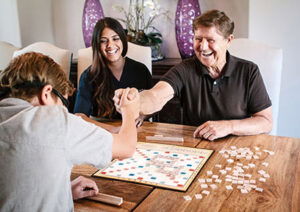Happy diminishing returns? Largely tongue-in-cheek, the expression typically applies to money—meaning it can only buy a fixed level of happiness before the joy of accumulating starts to wane. But what about stuff: the objects we collect throughout our lifetime that we just can’t seem to get rid of? What happens when we acquire too much stuff?
If you’re a senior, or are looking out for an aging loved one, stuff may make us happy for a time, but as we age what we accumulate can present challenges throughout our living environment. Clutter resulting from stacks of mail, paperwork, packages, magazines and the like on surfaces, for example, can contribute to feelings of confusion and overwhelm, something an older adult with cognitive issues needs less, not more, of.
Statistics also tell us that each year 36 million Americans, or one in four adults over age 65, experience a fall. That number increases every five years. The U.S. Centers for Disease Control and Prevention (CDC) reports falls are the leading cause of injury-related deaths for people over age 65.
While some senior falls are caused by physical decline, balance and mobility issues, clutter in one’s surroundings can present hazards to navigate, increasing the opportunities to trip and break a leg, arm, hip, neck, ribs, require stitches, sustain head trauma, or suffer internal injuries. If doorways are blocked, or even partially blocked, first responders may have trouble entering the premises or getting into specific rooms. Also, if caregivers are working in the home, it’s especially important that they have a safe, adequate berth in which to maneuver and support the client. With challenges mounting as seniors age, the last thing a caregiver needs to worry about is steering a client around piles of personal belongings, knickknacks, souvenirs, memorabilia, excess or oversized furniture too big for a space or pieces of furniture placed too close together, improperly stored equipment—including walkers, wheelchairs, oxygen concentrators, shower chairs and more.
Adaptive Advantages for Safe Senior Living
In some cases, a safer living environment isn’t all about clutter and may warrant some degree of adaptive remodeling, potentially including lowering of countertops and vanities, adding grab bars, doorway expansion and installing a roll-in shower to best accommodate a wheelchair. VA grants such as HISA: Home Improvements and Structural Alterations, are available to assist with home modification for disability access, and long-term care insurance (LTCi) benefits may also cover all or some remodeling. Many veterans may not be aware of their potential eligibility for financial assistance from the government. An Amada Senior Care advisor can help them determine whether they are eligible for VA Aid and Attendance benefits or other forms of financial support like an LTCi policy through a free care needs consultation.
Kimberly Akers, co-owner of Amada Senior Care in Mesa, Arizona, identified $16,000 worth of LTCi benefits toward an essential bathroom modification for senior client Steve Fishman, who has ALS. “It was his and his wife’s desire for him to remain in the home as long as possible,” Kimberly says. The retrofitting—which included a roll-in shower and taking down a wall between commode and shower to become more accommodating for client and caregiver—were high on the agenda.
According to Steve, 78, a retired marketing and advertising executive, “There was also a lip and fixed glass doors in the shower that had to be removed to better accommodate the wheelchair. There was plumbing in the wall taken down between the commode and shower that had to be relocated, and the entire floor had to be made even with the shower’s roll-in access,” he explains. “It all had to do with my ability to access my bathroom facility more easily, providing greater ease for the caregiver as well.
“Most people don’t read the fine print in their LTCi policy,” he adds, “or if they do, it’s confusing. For example, my policy said it covered equipment. I assumed that meant wheelchairs, etc. If not for Amada, I’d never have known that it may include remodeling—that I could be reimbursed for the whole thing, which I was.”
“Though our priority is the client’s safety,” Kimberly says, “when you think about it something like this can save the insurance company more money in the long run, making it possible for the insured to stay in the home rather than entering a facility.”
Taking Action for Yourself or a Senior Loved One
In addition to any adaptive remodeling, the following ideas may help ensure your senior loved one’s environment does not present a fall risk—making it more conducive to safe, accident-free living:
- The adage “a place for everything and everything in its place” was never more important than when reorganizing a senior’s living space. Make sure there are appropriate and out-of-the-way baskets and/or bins for anything used temporarily, such as blankets or pet toys, and reading or knitting material. Installing shelves where there may be none is also helpful, as is a bookcase if it will not impede the room’s flow.
- If it’s time to purge the environment of excessive knickknacks or memorabilia, taking photographs for digital storage can work wonders in enabling visible access to these memories whenever the senior wants to see them, without physically having them in the environment.
- Should the prospect of decluttering after years of living a certain way be overwhelming, hiring a professional to go through the home with the senior and/or family members, removing obstacles, organizing and teaching everyone how to maintain the space is always a good idea.
“Creating a Safe Home Environment for Our Senior Loved Ones” written by Beth Herman, Amada blog contributor.















